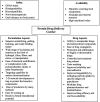Advances in Oral Drug Delivery
- PMID: 33679401
- PMCID: PMC7933596
- DOI: 10.3389/fphar.2021.618411
Advances in Oral Drug Delivery
Abstract
The oral route is the most common route for drug administration. It is the most preferred route, due to its advantages, such as non-invasiveness, patient compliance and convenience of drug administration. Various factors govern oral drug absorption including drug solubility, mucosal permeability, and stability in the gastrointestinal tract environment. Attempts to overcome these factors have focused on understanding the physicochemical, biochemical, metabolic and biological barriers which limit the overall drug bioavailability. Different pharmaceutical technologies and drug delivery systems including nanocarriers, micelles, cyclodextrins and lipid-based carriers have been explored to enhance oral drug absorption. To this end, this review will discuss the physiological, and pharmaceutical barriers influencing drug bioavailability for the oral route of administration, as well as the conventional and novel drug delivery strategies. The challenges and development aspects of pediatric formulations will also be addressed.
Keywords: biodegradable; lipophilic; nanoparticles; oral drug delivery; solubility; stomach.
Copyright © 2021 Alqahtani, Kazi, Alsenaidy and Ahmad.
Conflict of interest statement
The authors declare that the research was conducted in the absence of any commercial or financial relationships that could be construed as a potential conflict of interest.
Figures



References
-
- Abd El-Salam M. H., El-Shibiny S. (2012). Formation and potential uses of milk proteins as nano delivery vehicles for nutraceuticals: a review. Int. J. Dairy Technol. 65 (1), 13–21. 10.1111/j.1471-0307.2011.00737.x - DOI
-
- Alqahtani M. S., Podaralla S., Kaushik R. S., Reineke J., Woyengo T., et al. (2017). Food protein based core-shell nanocarriers for oral drug delivery: effect of shell composition on in Vitro and in Vivo functional performance of Zein nanocarriers. Mol. Pharmaceut. 14 (3), 757–769. 10.1021/acs.molpharmaceut.6b01017 - DOI - PubMed
-
- Alqahtani M. S. A., Alqahtani A. S. A., Baji R. S. S. (2019). Method of synthesizing lignin-based nanocompositions. Google Patents.
-
- Alqahtani M. S., Alqahtani A., Al-Thabit A., Roni M., Syed R. (2019). Novel lignin nanoparticles for oral drug delivery. J. Mater. Chem. B. 7 (28), 4461–4473. 10.1039/c9tb00594c - DOI
Publication types
LinkOut - more resources
Full Text Sources
Other Literature Sources

